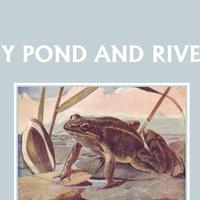CHAPTER 9. ALONG THE RIVER
LET us stroll a short distance along the river. How pretty it is, with the evening sun shining through the trees! What a number of little creatures are enjoying themselves in the air and in the water!
Pale little Tommy, who has come from London for a holiday, slips his hand in mine and says, "I wish I could live in the country." When he goes back to his own home in a narrow street, where there is only a hard pavement instead of green grass, and no shady trees nor flowing water, he will remember this walk by the river.
Look at those fish, about three inches long, swimming up and down under the bridge. Those are bull-heads. They are called so because they have such broad, thick heads. And they have a sharp spine on each side of their head, which we might call the bull's horns. You will feel those spines if you try to hold them in your hand. The kingfisher knows them well enough, if he tries to swallow one, for they stick in his throat.
You boys call them "miller's thumbs." I wonder why you think that millers have broad thumbs? The bull-heads hide under stones, and eat water insects, and the eggs of other fish. Ah! Fred has caught one and put it in the bottle. Now Tommy can see what a lovely eye the bull-head has, and the red, green, brown and yellow colours on his scales.
How busy those flies are with long wings and three long bristles on their tails. They are May-flies rising and falling over the water. They are not feeding, for May-flies do not eat, and only live a few hours. But they have lived a long time under water as grubs, like the dragon-fly grub. They only want now to lay their eggs and die.
The gnats flying over that quiet pool near the mill are quite different. One has just pricked my hand and sucked some blood, so I know that he can feed. But then gnats have not had so long a life in the water as the May-flies.
Those gnats flying over the pool were only born a few weeks ago. Their mother laid some sticky eggs, each not bigger than the point of a pin, and left them in a packet on the top of the still water. They were very soon hatched, and a number of grubs came out, looking like very tiny worms with fine hairs on their sides. Each swam about in the water and ate specks of weed.
Why do you think they swam with their heads down? Because they could only breathe near their tails, and so had to stick them up in the air.
In about three weeks each grub had changed his skin three times. The fourth time he came out with a wrapper round him, and if you could have looked at him then, you would have seen a perfect gnat, with wings, cuddled up inside.
Now he had to creep out, and that was very risky. For if he fell in the water he would be drowned. So he stretched himself very carefully on the top of the pool, and began to push his head through a slit in the wrapper.
Then he drew himself gently out, and stood on tiptoe on the empty skin, which floated like a boat on the water. He spread his wings, and then he was safe and flew away. Sometimes the wind blows him over before he can get out, and then he is drowned.
If you take a pail of water out of a pond in May, and keep it in the open air, you may be able to see a gnat grow up, for there will most likely be a great many in it. But you must have sharp eyes, for they are very tiny.
And now the sun is setting and birds and beasts and flowers are all going to rest. Soon the night-moths and the owls and bats will be coming out. We must go home.

